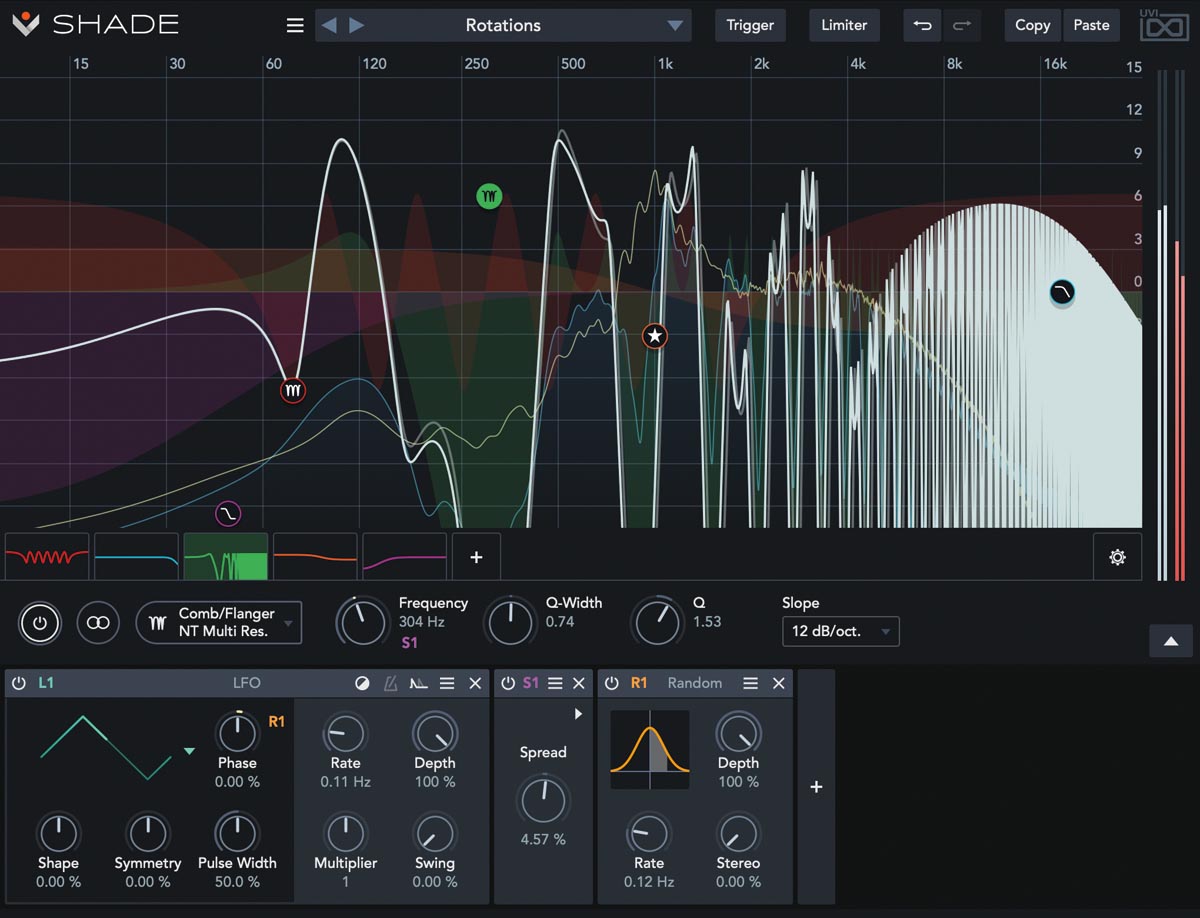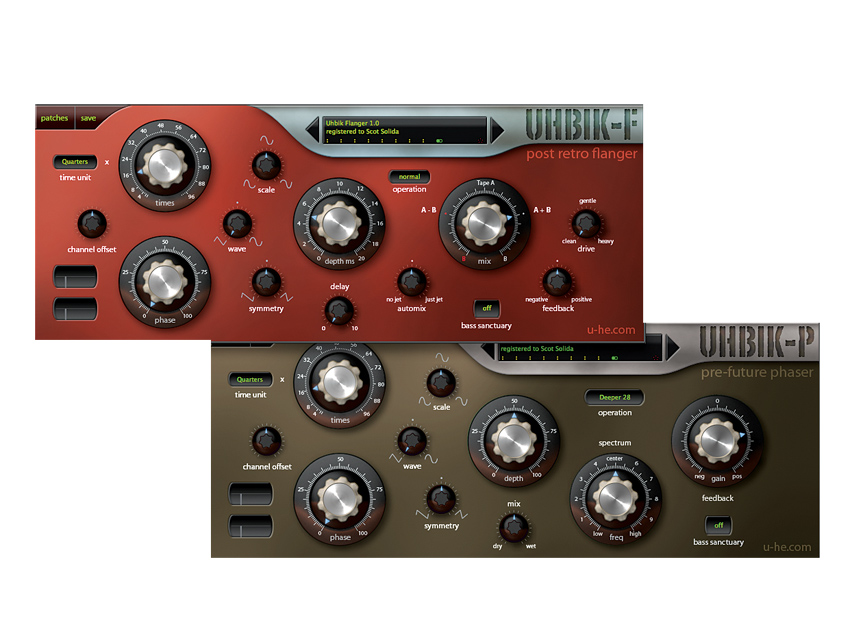MusicRadar Verdict
Shade is a powerful next-generation EQ plugin that delivers powerful static EQs and a myriad of filter-derived animated effects.
Pros
- +
Very extensive set of filter types.
- +
Good choice of modulators.
- +
Dynamic trigger options.
- +
Decent set of presets.
- +
External side chain.
- +
Intuitive graphic interface.
Cons
- -
Not much.
MusicRadar's got your back
What is it?
UVI is best known for its Workstation and Falcon hybrid synth, which collectively deliver an impressive array of sample and synth-based sounds.
It is perhaps less well known for its effects, which include the excellent Relayer delay and Sparkverb algorithmic reverb. Up for review is Shade (VST, AU, AAX), the latest addition to its effects range. It describes it as a creative filter and EQ, and a quick look at the spec reveals extensive modulation. So, let’s find out what‘s actually going on.
EQ Basics
Shade can be used as a regular EQ, and to that end, it has potentially unlimited bands and a whopping 35 filter shapes that range from regular peak, shelving and high/low-pass including resonant and multi-resonant variants, to more exotic comb filters, resonant notch filters and so on.
A quick tweak proves these to be incredibly flexible, and in addition to very narrow Qs, they also include extreme Slope settings (up to 2000dB/octave). So, you can create very precise shapes, and at their most extreme these will deliver very aggressive results.
UVI have put together a decent set of more than 150 presets that showcase its many capabilities
Bands can be added, modified, duplicated, solo’d and even adjusted collectively in the graph area or you can modify the parameters in the Filter Tab below. Bands also include mono, stereo and mid/sides processing options so you can quickly and flexibly EQ specific channel components in different ways.
To aid regular EQing there are a bunch of Utility presets with preassigned filter types and also some hardware-inspired examples (API 5 EQ for example) that use Shade’s advanced features to emulate classic EQ behaviours. Further features include an output Limiter, background frequency analyser and external side chain.
In typical UVI style, the whole thing is highly intuitive, looks great and if that’s as far as it went, we’d be praising Shade for being an awesomely flexible modern EQ plugin. However, they’ve added a whole further layer of complexity in the form of modulation, and that truly takes it to the next level.

Modulation
Shade features nine modulators that can be used to control multiple targets including EQ parameters and other modulators. This transforms Shade into a creative EQ, delivering dynamic, moving and animated effects.
Modulators are accessed via the flap down scrolling panel at the bottom of the window and you simply drag and drop them onto the required target. One plugin can load multiple instances of each modulator type and they’re clearly labelled (multiple envelope instances show as E1, E2, E3 and so on) so it’s clear at the target parameter which modulators you’re dealing with.
Parameter specific modulation depth is then adjusted by dragging the Modulation Target icon. A halo indicator around the relevant knob shows you the settings that you’ve achieved.
Typical modulators such as syncable adjustable LFOs and regular AHD envelopes are joined by more complex examples such as a multi-step envelope generator (MSEG), a Random Generator and a Signal Follower. Rounding things off are even more exotic options including XY Pad, Macro, Stereo Spread and Figure (a continuously cycling 2D generator with up to eight vertices).

• u-he Uhbik
Uhbik offers superior-sounding, sophisticated processors at what works out to be around $25 apiece. Taken as a collection, Uhbik is capable of transforming even the most mundane sound into something interesting and inspiring.
• FabFilter Pro-Q 3
Pro-Q 3 added to what was already an admirably flexible and superb sounding EQ with a handful of welcome new features.
Obviously, this is pretty powerful but also needs to be viewed in the context of the available filters. The Phaser and Flanger/Comb Filter shapes very much lend themselves to LFO-style modulation.
Meanwhile, the special Gain filter or any gain parameter for that matter can be used in conjunction with the Envelope Follower to create dynamic effects. There’s also a handy Make Dynamic option that automatically assigns a Follower to the selected band, turning it into a dynamic EQ.
Macros can be put to work to control multiple parameters. One such example would be an EQ where Q is influenced by gain, and this is what you’ll find in the API 5 EQ preset mentioned above. What’s more, the Random Generator can introduce subtle ‘humanising’ changes to EQ parameters as well as more extreme effects.

Filter styles
Shade includes a bunch of quite regular filter shapes perfect for typical EQ duties and these are suitably labelled to show their purpose. The filters are still pretty powerful with 30dB cut/boost and very sharp Q options (the shelves go up to 2000dB/octave).
These shapes are complemented by some very flexible resonant and multi-resonant variants and a good example are the resonant shelves. Here you get both Q-Up and Q-Down parameters which allow you to individually tailor the pre-shelf dip and cutoff frequency resonance. Meanwhile, multi-resonant examples include high, low, bandpass and notch filters.
It would be easy to get wrapped up in Shade’s awesome flexibility, and it clearly is an impressive creative tool. But it’s also a rather excellent EQ with a broad selection of highly flexible filters
These feature additional resonant peaks across the frequency range, and the spacing of these is dependent on the slope. Shade also includes 15 Phaser and Comb Filter/Flanger filter shapes in regular, resonant and multi-resonant formats, and these form the basis of many of its more interesting effects.
Finally, the Special category includes three options – Gain, Tilt and Xpander. Gain is an overall level control that can be modulated to create a compressor, Xpander is a multimode filter with overdrive and a choice of drive types and Tilt is a traditional tilt-style EQ.
Performance and verdict
This could all prove to be a bit overwhelming, but UVI have put together a decent set of more than 150 presets that showcase its many capabilities and these include regular EQs, dynamics, distortion and of course complex animated effects.
Over in that last category, you can find panning filtering effects (Hypnosis), super smooth phasing (Phasing Movement) and rhythmic effects (Lower Control) alongside more extreme examples of flanging craziness (Rotations). And there are plenty of transformative effects too such as the machinelike Enitine and vocalish Talk Bit.
Meanwhile, amongst the dynamic and distortion effects, there’s everything from a basic compressor and handy de-esser to quite respectable amp emulations and general distortions.
It would be easy to get wrapped up in Shade’s awesome flexibility, and it clearly is an impressive creative tool. But it’s also a rather excellent EQ with a broad selection of highly flexible filters. It’s certainly an intriguing combination, but also one that’s hard to leave alone once you get started. Either way, it’s exactly what we want from a next-generation EQ. A truly wonderful plugin.
MusicRadar verdict: Shade is a powerful next-generation EQ plugin that delivers powerful static EQs and a myriad of filter-derived animated effects.
The web says
”The impressive nature of Shade allows for complicated effects or subtle processing, at whichever level you require. The comparative ease with which it is possible to exploit numerous and simultaneous modulation sources will create some beautifully complex colours.”
MusicTech
Hands-on demos
UVI
Mikael Baggström
Specifications
- TYPE: Creative filter and EQ plugin (AU, AAX, VST and VST3)
- KEY FEATURES: Advanced EQ, mix tool with 35 filter shapes, 9 modulators, MSEG and follower, side-chain and cross modulation support
- SYSTEM REQUIREMENTS: 200MB disk space / 4 GB RAM; Mac OS X 10.9 Mavericks to macOS 10.15 Catalina (64-bit); Windows 8 to Windows 10 (64-bit), iLok account [free download]
- CONTACT: UVI
Computer Music magazine is the world’s best selling publication dedicated solely to making great music with your Mac or PC computer. Each issue it brings its lucky readers the best in cutting-edge tutorials, need-to-know, expert software reviews and even all the tools you actually need to make great music today, courtesy of our legendary CM Plugin Suite.
“I used everything I knew about music”: How Green Day exceeded expectations with their most ambitious song
YouTube just added AI tools that makes musicians, library music and video editors redundant
“Every one of them said yes without hesitation": Hank Marvin and Roger Taylor have just remade a '60s classic for charity











